Expert Foot & Ankle Treatment from Michigan’s #1 Podiatrist - Balance Foot & Ankle Specialist
Stop The Stab—Start The Fix.
Shooting Pain in Big Toe - Causes, Symptoms & Best Treatment
Shooting pain in the big toe is usually caused by nerve irritation and pain caused during the day. Learn the 100% best way to get the pain feeling better!
Look:
- Big toe joint pain can be improved with a few simple treatment changes.
- We are foot doctors & we see this problem get better almost every day.
- The goal is to solve this problem without medication or surgery if possible.
So, let’s GO!
Shooting Pain in Your Big Toe? Here’s What It Means
A sudden, electric-like jolt through the big toe can be alarming. Whether it strikes while you’re walking, working out, or relaxing in bed, shooting pain often signals an underlying issue—ranging from nerve irritation to joint wear-and-tear. Understanding the root cause is the first step toward lasting relief.
Why Does Big-Toe Pain Shoot Like Lightning?
Shooting pain usually stems from irritation or compression of the nerves and soft tissues around the toe joint. Common culprits include:
Nerve Entrapment (e.g., Morton’s neuroma reaching the hallux)
Gout or acute arthritic flare-ups
Hallux rigidus (big-toe arthritis)
Turf toe or hyperextension injuries
Diabetic neuropathy
Stress fractures at the distal metatarsal
Ingrown toenails pressing on nerve endings
Early evaluation prevents minor problems from becoming permanent disabilities—especially if you’re diabetic or highly active.
Big Toe Joint, Hammer Toe & Bunionette Problems
Stop Toe Curling in Its Tracks—Get a Personalized Foot Assessment Today
Don’t let curled toes dictate your comfort. Our board-certified podiatrists pinpoint the root cause and design treatment plans that restore flexibility and ease pain. Call (810) 206-1402 or book an appointment online and take the first confident step toward healthier feet.
Top-Rated Foot Care Products Recommended by Podiatrists
Trusted Solutions To Soothe, Protect, and Support Your Feet
Finding the best products for managing peripheral neuropathy and diabetic foot pain can make a world of difference in your daily comfort and mobility.
When it comes to managing foot pain from conditions like plantar fasciitis, flat feet, or diabetic neuropathy, the best orthotics can offer crucial support and relief.
Choosing the best shoes for foot conditions like neuropathy, plantar fasciitis, or flat feet is essential for pain relief and long-term foot health.
Shooting Pain In Big Toe Joint Treatment Video
Shooting Pain In The Left Big Toe or Right Big Toe Causes:
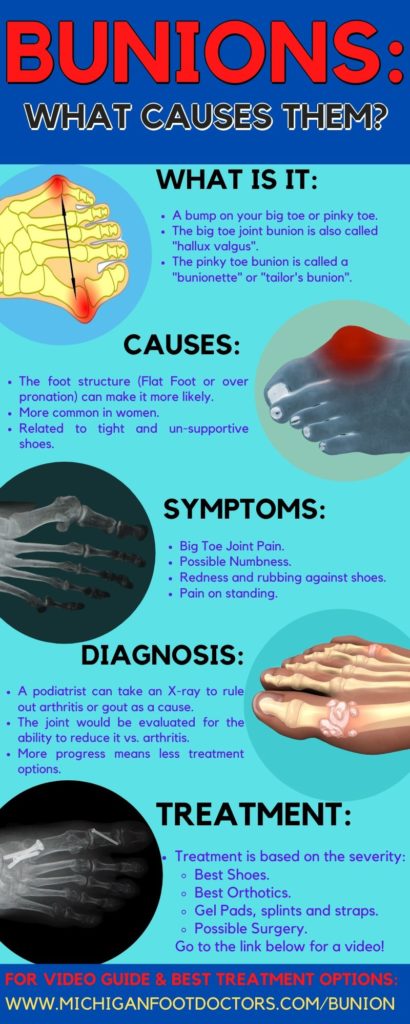
Bunion Pictures & Photo Gallery:
Look:
- The associated photos are pictures of bunions.
- A big toe joint bunion is a prominence of the first metatarsal phalangeal joint.
- A tailor’s bunion is the prominence of the fifth metatarsal phalangeal joint.
- There are multiple stages of bunions ranging from minimal dislocation to severe dislocation to severe dislocation with arthritis.
- It is important to note that the sesamoid bones dislocate from the big toe joint and that the bunion itself is more of a dislocation injury than an arthritic injury.
- Although we frequently see bunions that also have arthritis, and is much more likely.
- We do perform minimally invasive bunion surgery at our clinic to limit the length of recovery time needed.
Please click on the gallery to read the description! Feel free to share pictures.
Shooting Pain in Big Toe Overview:
- Shooting pain in the big toe joint is secondary to nerve irritation.
- There are numerous different causes of big toe joint shooting pain: bunion pain, arthritis, tendon ligament, and joint capsule injury.
- If these structures are agitated, then the nerves will be agitated.
- Nerves will cause sharp, shooting, and tingling pain in the big toe joint.
- We have detailed a great treatment guide for your shooting, sharp, tingling big toe joint pain.
Most Common Causes:
1. Bunion:
- The bunion is a dislocation of a joint called your first metatarsal phalangeal joint.
- This is more common in women than men. It is most common in the age range of 30 to 50 years old.
- This is associated with unsupportive shoes, standing all day, and flexibility.
- Men are more likely to get big toe joint arthritis.
- This is probably one of the most common big toe joint pain causes.
- Click on the above link for all the treatment, diagnoses, and causes of bunion pain.
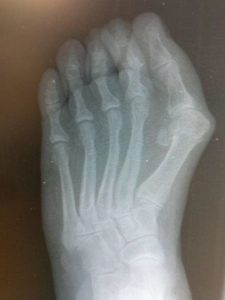
2. Gout:
- Gout is a prevalent cause of big toe joint pain.
- Is gout is known as the King’s disease, as it has to do with the buildup of DNA products called purines?
- If your body cannot keep up with metabolizing these, they will lead to the buildup of uric acid within the joints.
- The big toe joint is the most common in 90% of cases.
- This is most common when you wake up in the morning, and your pain is 10 out of 10.
- This is definitely one where you want your podiatrist helping you treat it!
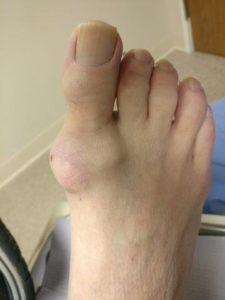
3. Hallux limitus:
- Hallux limitus refers to the inability to bend your big toe joint upwards.
- This usually precedes advanced arthritis. It is the start of the destruction of your cartilage in the big toe joint.
- This is usually the start of big toe joint arthritis.
- Click on the above link for everything you want to know about the condition!
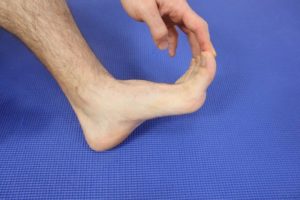
4. Hallux rigidus:
- Hallux rigidus refers to advanced arthritis inside the big toe joint.
- This is one of the most common conditions in the big toe joint behind bunions.
- This is more likely to happen in men than in women.
- This has to do with continued pressure on the big toe joint and poor flexibility throughout the ankle.
- This does not mean that you automatically need to do surgery to treat the condition.
- There are many treatments to relieve the pain and keep you walking pain-free. These include great shoes, great orthotics, and in some cases, surgery.
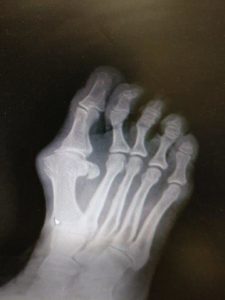
5. Sesamoiditis:
- This is the inflammation of two bones underneath your big toe joint.
- This is a complicated name to say! Thus it does not get the credit that it deserves.
- People with very high arched feet are very likely to get this condition.
- We see this quite a bit in basketball players that push off with their big toe joints to jump.
- Sesamoiditis refers to the inflammation of the two bones called sesamoids.
- These boats can also be broken, sprained, or just inflamed.
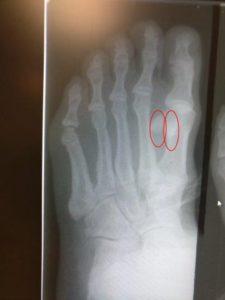
6. Turf toe:
- Turf toe refers to the stretching of the ligaments of the big toe joint.
- This is one of the most common foot injuries while playing sports. This happens to athletes running full speed and trying to stop very quickly and band across their big toe joints.
- This is very common in athletes such as soccer or football players.
- There are many stages and many different treatments for this condition.
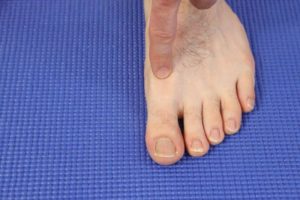
7. Broken Toe:
- A broken toe is very common. Sometimes it can be broken without significant force.
- In most cases, it is undeniable when you broke your big toe joint.
- This is deathly something you want to see a podiatrist for, as it can have long-term consequences and get you off work long-term.
- If left untreated, it is very common to lead towards cartilage or destruction and potentially arthritis of the big toe joint.
- Click the above link to find out what you need to do and see your podiatrist.
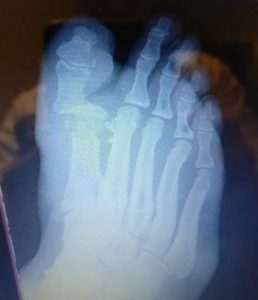
8. Swollen Toe:
- There are many different causes of a swollen big toe joint. Some of them are listed on this page.
- This is also very common in people that have fluid retention and swollen ankles.
- There are many, many causes for this.
- If it is only in one foot but not the other, it likely has to do with an injury.
- The above link will show you even more causes.
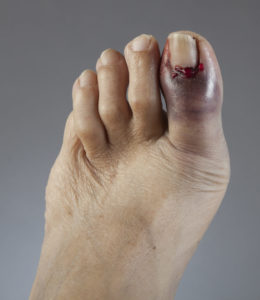
9. Dislocated Toe:
- A dislocated toe is the function of two major causes.
- With bunions, we do see this very common, especially on x-ray. It could be a major cause for the big bump on your big toe joint
- One is a very severe bunion that can lead to dislocation of the big toe joint.
- The second cause is significant trauma likely to fracture or tearing of the league of the big toe joint.
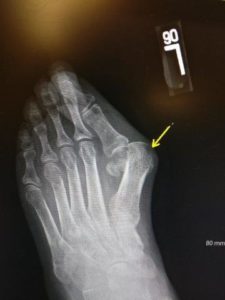
10. Hallux Varus:
- Hallux Varus is a condition where your big toe joint bends inward. This is the opposite of a bunion for me.
- This is most common in people who have had bunion correction surgery.
- It is also common for people that have nerve disorders or spasticity potentially.
- This is not the most common cause of big toe joint pain.
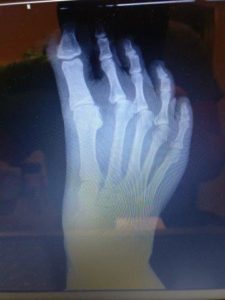
11. Flexor Hallucis Tendinitis:
- The flexor hallucis tendon is a long tendon that extends from the tip of your big toe joint along the bottom.
- This tendon is responsible for bending your big toe downward.
- If you spend a lot of time pushing off the ground, this may be very sore.
- This is a huge, powerful, and important tendon.
- In some sports such as dancing and for ballerinas, it is essential and frequently injured muscle.
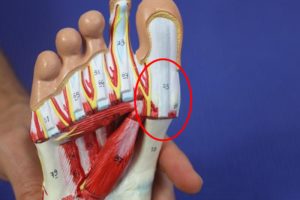
12. Foot Arthritis:
- Foot arthritis is usually caused by repetitive injury or destruction of the cartilage within the joint.
- This is very, very common inside the big toe joint. Here is a picture of what it looks like.
- This is a prevalent condition that we see very regularly.
- Click on the link above to see what big toe joint arthritis looks like.
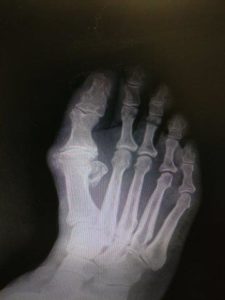
Best Bunion Relief Infographic:
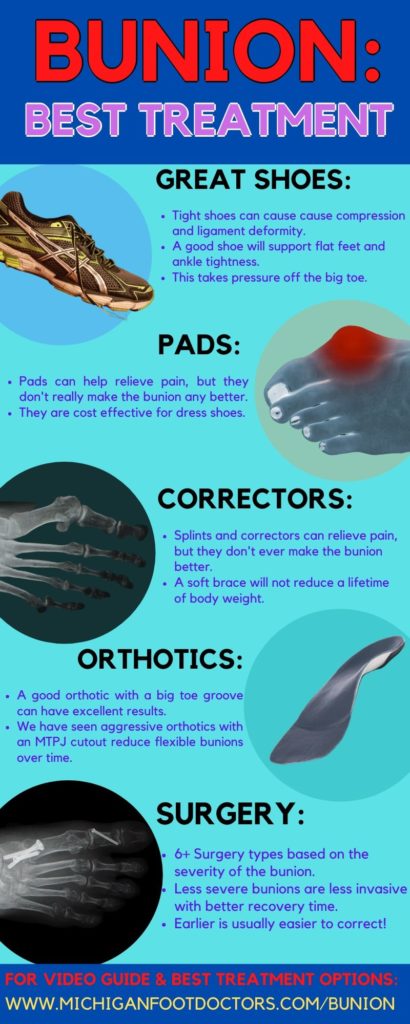
Big Toe Joint Injury or Surgery Treatment:
- If you think you might have a severe turf toe, a severe tear or sprain, a broken big toe joint or broken big toe, or you have just had surgery: this guide may be able to help you!
- Just make sure to check with your podiatrist because a severe injury will require imaging, biomechanical evaluation, and a good discussion to prevent anything from going more wrong.
- For surgery, purposes make sure to discuss with your podiatrist To see what is recommended, as every surgery is unique, and there are pros and cons to all treatment methods.
Big Toe Joint Fracture, Sprain, or Surgery Products:
- If you have a traumatic injury such as a broken bone or ligament tear, these products may be able to help you.
- The best way to do this is, of course, to see your podiatrist and get evaluated with an x-ray, ultrasound, and potentially even an MRI or CT scan.
- If you cannot do so, it may benefit you to be in a cast, fractured boot, or even keep the weight off of it with a rolling knee scooter or other protective devices.
- We as podiatrists frequently take patients off work for a very long period of time when they suffer a traumatic injury. Unfortunately, there is no other way around us in labor jobs.
- If you have a sit-down job, there are ways to get people back to work quicker, but this can be impossible otherwise.
- Just remember these injuries can take a very long time, specifically 2 to 3 months or more, to come back from if you’re going to be on your feet all day. There is a long recovery time and healing time in most cases.
Big Toe Joint Injury & Surgery Immobilization:
- There are pros and cons to using a boot to treat your big toe joint injury. If you are immobilized too long, the cons are that you will gradually become stiff and overworked to your other leg.
- The Pros are that your injured heel will hopefully have a chance to heal gradually!
- Our favorite fracture boots and their supplies:
Best Fracture Boots & Covers
Best Tall Boot
Best Short Boot
Best Fracture Boot Balance Device
Best Cast Shower Cover




Price:
$77.88
$40.00
$39.95
$15.99
Overview:
Excellent reviews at 4.6/5 with over 800+ Reviews:
Very good reviews. This is 4.3/5 ratings on over 3,000+ reviews.
Outstanding reviews: 4.3/5 for 1,000+ reviews! Prevents hip, knee and back pain.
Amazing Reviews at 4.6/5 at 500+ reviews. Best reviewed and cost effective bag.
Pros:
It has an air bladder for extra cushion. It is tall for extra support, as well as air bladder.
Excellent lower cost walking boot. With a orthotic and cushion, it really keeps pressure off of your ankle.
This works great to balance the opposite foot. This prevents the back, hip and knees from having any pain.
It is very effective but not perfect. The price is really good and it has excellent reviews.
Cons:
The inner sleeve can ride lower and the plastic around the rim can irritate the boot.
Less support with the less than full length boot. It is more comfortable but less supportive.
Does not work that great for slippers and less supportive shoes.
It can still leak, so be careful!
Crucial Tips:
Make sure your lift the cushioning material along the hard plastic rim. Make sure to keep it pumped up. Use an orthotic and a lift on the other side.
Use a lift for the other foot to prevent back and hip problems. Also use an orthotic for the flat foot bed.
This is very cost effective and well worth it. Just make sure both shoes have good supportive orthotics.
Just be careful with this is not perfect. It can still get wet underneath.
Affiliate Link (Buying through these links will connect you to Amazon):
Best Fracture Boots & Covers
Best Tall Boot

Price:
$77.88
Overview:
Excellent reviews at 4.6/5 with over 800+ Reviews:
Pros:
It has an air bladder for extra cushion. It is tall for extra support, as well as air bladder.
Cons:
The inner sleeve can ride lower and the plastic around the rim can irritate the boot.
Crucial Tips:
Make sure your lift the cushioning material along the hard plastic rim. Make sure to keep it pumped up. Use an orthotic and a lift on the other side.
Affiliate Link (Buying through these links will connect you to Amazon):
Best Fracture Boots & Covers
Best Short Boot

Price:
$40.00
Overview:
Very good reviews. This is 4.3/5 ratings on over 3,000+ reviews.
Pros:
Excellent lower cost walking boot. With a orthotic and cushion, it really keeps pressure off of your ankle.
Cons:
Less support with the less than full length boot. It is more comfortable but less supportive.
Crucial Tips:
Use a lift for the other foot to prevent back and hip problems. Also use an orthotic for the flat foot bed.
Affiliate Link (Buying through these links will connect you to Amazon):
Best Fracture Boots & Covers
Best Fracture Boot Balance Device

Price:
$39.95
Overview:
Outstanding reviews: 4.3/5 for 1,000+ reviews! Prevents hip, knee and back pain.
Pros:
This works great to balance the opposite foot. This prevents the back, hip and knees from having any pain.
Cons:
Does not work that great for slippers and less supportive shoes.
Crucial Tips:
This is very cost effective and well worth it. Just make sure both shoes have good supportive orthotics.
Affiliate Link (Buying through these links will connect you to Amazon):
Best Fracture Boots & Covers
Best Cast Shower Cover

Price:
$15.99
Overview:
Amazing Reviews at 4.6/5 at 500+ reviews. Best reviewed and cost effective bag.
Pros:
It is very effective but not perfect. The price is really good and it has excellent reviews.
Cons:
It can still leak, so be careful!
Crucial Tips:
Just be careful with this is not perfect. It can still get wet underneath.
Affiliate Link (Buying through these links will connect you to Amazon):
Big Toe Arthritis and Hallux Rigidus:
- One of the best treatment options for a stiff big toe is a stiff orthotic.
- The big toe can become arthritic, and what causes the pain is the bone grinding on a joint that cannot move.
- Getting a rigid carbon insole can make a huge difference in preventing the bend of the big toe joint.
- Out of the big toe joint products in the next table, the carbon insole is worth looking at for relieving the big toe joint bed.
- A good over-the-counter orthotic can provide a similar result, and we would otherwise prefer those.
Best Big Toe Joint Injury Treatment
EstCarbon – Carbon Fiber Insole – 1 pc, Men 12-12.5, Women 13 – Unisex Orthotic Shoe Insert – Stiff Foot Plate – Turf Toe, Hallux Rigidus, Flat Feet, Plantar Fasciitis, Mortons Extension
OrthoSleeve Bunion Relief Socks, Patented Split-Toe Design with a Cushioned Bunion Pad Separates Toes, Relieves Bunion Pain and Reduces Toe Friction
Bunion Corrector and Bunion Relief, Bunion Splint Socks Pads for Hallux Valgus, Big Toe Joint, Hammer Toe, Toe Separators Straighteners Spacers with Foot Massage Ball for Women and Men, 8 Pieces
Doctor’s Choice Bunion Relief Quarter Sock with Split Toe Separator and Soft Cushioning for Hallux Valgus, (White/Black, Medium) Womens Shoe Size: 6-10




$52.99
$24.95
Price not available
$17.99
Overview:
Price range is $50+. Excellent overall reviews at 4.0/5 with 60+ ratings.
Price Range $20+. Excellent reviews at 4.2/5 with over 250+ ratings.
Decent option for rubbing and bunion pain while walking. Low cost and 4.0+ rating.
Price Range: $12+, Good value. Great reviews at 30+ reviews at 4.4/5
Pros:
Great for what they do, most bad reviews are confusion regarding the fit into shoes. Make sure it is a running shoe or broad toe box.
Great for athlete’s who are running and having rubbing inside their shoe. These can work well for big toe joint pain, bunions, hallux rigidus and turf toe type injuries.
These are great for lower activity older people. They can straighten and cushion the big to joint while walking.
They can be combined with gel pads as well as shoes and the sock. Another great layer of protection.
Cons:
These will have a very difficult fit into a pointed and narrow shoe. This can cause issues for women’s shoes and men’s dress shoes.
Can get sweaty and the durability is likely less than 1 year. Especially if heavy duty running.
The big toe joint will not correct if there is little chance of it permanently correcting the foot.
Not perfect and by themselves may not fix your bunionette(tailor’s bunion) pain. They can break down over time.
Crucial Tips:
These work best with a good well fitting shoe. A tapered or dress shoe may have a difficult fit.
Make sure to combine with a great running shoe as recommended, possibly a carbon fiber orthotic that can limit hyperextension.
The best best is to focus on good shoes and good orthotics. They will work better than this brace in almost all cases. Save these for lower activity older and more arthritic patients.
These are a lower cost budget version of the orthosleeve bunion sock. The difference is these ones include the 5th toe tailor’s bunion as well.
Affiliate Link (Buying through these links will connect you to Amazon):
Best Big Toe Joint Injury Treatment
EstCarbon – Carbon Fiber Insole – 1 pc, Men 12-12.5, Women 13 – Unisex Orthotic Shoe Insert – Stiff Foot Plate – Turf Toe, Hallux Rigidus, Flat Feet, Plantar Fasciitis, Mortons Extension

$52.99
Overview:
Price range is $50+. Excellent overall reviews at 4.0/5 with 60+ ratings.
Pros:
Great for what they do, most bad reviews are confusion regarding the fit into shoes. Make sure it is a running shoe or broad toe box.
Cons:
These will have a very difficult fit into a pointed and narrow shoe. This can cause issues for women’s shoes and men’s dress shoes.
Crucial Tips:
These work best with a good well fitting shoe. A tapered or dress shoe may have a difficult fit.
Affiliate Link (Buying through these links will connect you to Amazon):
Best Big Toe Joint Injury Treatment
OrthoSleeve Bunion Relief Socks, Patented Split-Toe Design with a Cushioned Bunion Pad Separates Toes, Relieves Bunion Pain and Reduces Toe Friction

$24.95
Overview:
Price Range $20+. Excellent reviews at 4.2/5 with over 250+ ratings.
Pros:
Great for athlete’s who are running and having rubbing inside their shoe. These can work well for big toe joint pain, bunions, hallux rigidus and turf toe type injuries.
Cons:
Can get sweaty and the durability is likely less than 1 year. Especially if heavy duty running.
Crucial Tips:
Make sure to combine with a great running shoe as recommended, possibly a carbon fiber orthotic that can limit hyperextension.
Affiliate Link (Buying through these links will connect you to Amazon):
Best Big Toe Joint Injury Treatment
Bunion Corrector and Bunion Relief, Bunion Splint Socks Pads for Hallux Valgus, Big Toe Joint, Hammer Toe, Toe Separators Straighteners Spacers with Foot Massage Ball for Women and Men, 8 Pieces

Price not available
Overview:
Decent option for rubbing and bunion pain while walking. Low cost and 4.0+ rating.
Pros:
These are great for lower activity older people. They can straighten and cushion the big to joint while walking.
Cons:
The big toe joint will not correct if there is little chance of it permanently correcting the foot.
Crucial Tips:
The best best is to focus on good shoes and good orthotics. They will work better than this brace in almost all cases. Save these for lower activity older and more arthritic patients.
Affiliate Link (Buying through these links will connect you to Amazon):
Best Big Toe Joint Injury Treatment
Doctor’s Choice Bunion Relief Quarter Sock with Split Toe Separator and Soft Cushioning for Hallux Valgus, (White/Black, Medium) Womens Shoe Size: 6-10

$17.99
Overview:
Price Range: $12+, Good value. Great reviews at 30+ reviews at 4.4/5
Pros:
They can be combined with gel pads as well as shoes and the sock. Another great layer of protection.
Cons:
Not perfect and by themselves may not fix your bunionette(tailor’s bunion) pain. They can break down over time.
Crucial Tips:
These are a lower cost budget version of the orthosleeve bunion sock. The difference is these ones include the 5th toe tailor’s bunion as well.
Affiliate Link (Buying through these links will connect you to Amazon):
Offloading and Scooter Treatment:
- If you cannot use your foot, it needs to be immobilized: we have found success with offloading the scooters in these products.
- Crutches can be difficult long term, whereas scooters can really help you get around and to work if you have a sit-down job in this been okay-ed with your podiatrist.
- These are our favorite knee scooters and walking devices:
Best Fracture Scooters
Best Value & Best Seller Knee Rolling Scooter.
Best All Terrain Heavy Duty Scooter.
Best Crutch Free Walking Device.
Best Elevating Specific Postop or Swelling Pillow




Price:
$119.99
$299.99
Price not available
Price not available
Overview:
Very good reviews at 4.5/5 with 3,000+ reviews. Great Price.
Excellent overall reviews at 4.4/5 with 1,300+ reviews. Great heavy duty all terrain.
Decent reviews at 3.9/5 with 4,000+ reviews. NOT for everyone!
Very good reviews at 4.7/5 with almost 2,000 Reviews. Simple job but does it well.
Pros:
Great reviews, great price overall, what more can you ask for?
Good for offroad, grass and dirt. This is the better choice for heavy and tall patients over 6 foot and heavy.
This is great for athletic and mobile people. We have found success for younger and more physically capable people.
Great pillow for the first 1-2 weeks after foot or ankle fracture and surgery. Decreased pain and swelling.
Cons:
Least durable and no real off-road capabilities.
It is more costly than the economy version.
DO NOT get this if you are older, have poor balance and poor mobility. Higher fall risk.
Basically it is a pillow that costs $50, if you are tight on money, don’t get it.
Crucial Tips:
These can be tough on the knee and the lower back. Combine with physical therapy.
If you are a bigger person at over 6ft tall, consider this. If you need to be at work or outside, this is great option.
This is better for very mobile and physically capable people. Do not get this if you have poor weight control or poor balance.
It can be very effective and does a great job, but if you are tight on cash, use it on a better boot or scooter.
Affiliate Link (Buying through these links will connect you to Amazon):
Best Fracture Scooters
Best Value & Best Seller Knee Rolling Scooter.

Price:
$119.99
Overview:
Very good reviews at 4.5/5 with 3,000+ reviews. Great Price.
Pros:
Great reviews, great price overall, what more can you ask for?
Cons:
Least durable and no real off-road capabilities.
Crucial Tips:
These can be tough on the knee and the lower back. Combine with physical therapy.
Affiliate Link (Buying through these links will connect you to Amazon):
Best Fracture Scooters
Best All Terrain Heavy Duty Scooter.

Price:
$299.99
Overview:
Excellent overall reviews at 4.4/5 with 1,300+ reviews. Great heavy duty all terrain.
Pros:
Good for offroad, grass and dirt. This is the better choice for heavy and tall patients over 6 foot and heavy.
Cons:
It is more costly than the economy version.
Crucial Tips:
If you are a bigger person at over 6ft tall, consider this. If you need to be at work or outside, this is great option.
Affiliate Link (Buying through these links will connect you to Amazon):
Best Fracture Scooters
Best Crutch Free Walking Device.

Price:
Price not available
Overview:
Decent reviews at 3.9/5 with 4,000+ reviews. NOT for everyone!
Pros:
This is great for athletic and mobile people. We have found success for younger and more physically capable people.
Cons:
DO NOT get this if you are older, have poor balance and poor mobility. Higher fall risk.
Crucial Tips:
This is better for very mobile and physically capable people. Do not get this if you have poor weight control or poor balance.
Affiliate Link (Buying through these links will connect you to Amazon):
Best Fracture Scooters
Best Elevating Specific Postop or Swelling Pillow

Price:
Price not available
Overview:
Very good reviews at 4.7/5 with almost 2,000 Reviews. Simple job but does it well.
Pros:
Great pillow for the first 1-2 weeks after foot or ankle fracture and surgery. Decreased pain and swelling.
Cons:
Basically it is a pillow that costs $50, if you are tight on money, don’t get it.
Crucial Tips:
It can be very effective and does a great job, but if you are tight on cash, use it on a better boot or scooter.
Affiliate Link (Buying through these links will connect you to Amazon):
Best Big Toe Joint Products:
- There are usually two phases to treating big toe joint pain
- The two phases of treatment include controlling the acute inflammation with protection and correcting the biomechanics, which led to the problem in the first place.
- If the tendons, joints, and ligaments are inflamed, they are almost frozen in place and cannot function properly.
- Inflammation can mean damage as well, in this most likely needs to be protected as the big toe joint heavily relies upon the weight-bearing joint. So consider discussing with your podiatrist the need for and offloading surgical shoes or boots.
- Once the inflammation is decreased, we need to correct the biomechanical causes to ensure that they can never become overworked and inflamed again!
- The key with an injury or surgery is to keep it protected initially, and when the bone and tendon heels, to get moving before stiffness can set in.
Best Bunion Specific Products:
- There are no perfect bunion treatment products.
- Most people end up disappointed after spending a lot of money on bunion pads, bunion gel pads, expensive bunion correctors, and bunion splints!
- The truth is a bunion is a biomechanical injury. The foot is flattening out, and the ankle is flattening out, causing the pain.
- Having a gel pad on the big toe has very little chance of fixing the deformity, although it can stop the rubbing and relieve a lot of the pain.
- This is why people sometimes wear splints and correctors. It holds the toe straighter so that the tissue and were’s and have left pain.
Best Bunion Treatment
Doctor’s Choice Bunion Relief Crew Sock with Split Toe Separator and Soft Cushioning for Hallux Valgus, (White/Black, Medium) Womens Shoe Size: 6-10
YogaToes GEMS: Gel Toe Stretcher & Separator – America’s Choice for Fighting Bunions, Hammer Toes (Small fits Shoe Sizes W: 7 and Over/M: 7 and Over) Sold as Pair
ZenToes Bunion Pain Relief Pads to Wear with Shoes – Moleskin Guards Protect Feet for Men and Women, All-Day Water-Resistant Self-Stick Adhesive – 24 Cushions
Caretras 2-Pack Bunion Corrector for Women & Men, Orthopedic Bunion Splint for Hallux Valgus Pain Relief, Big Toe Separator, Adjustable Day/Night Support, Comfortable Hammer Toe Straightener
Relax Tony Gel Toe Separators, Spreaders & Straighteners | Hammer Toe Separator to Relieve Foot Pain & Correct Toes | Toe Spacers for Feet with Overlapping Toes | Bunion Corrector for Women & Men
DUORUI 4 Pack Bunion Guards, Bunion Pads, Bunion Cushion, Toe Fixer, Gel Bunion Toe Spreader – (for Pain Relief from Crooked Toes, Pressure, and Hallux Bunions)






$12.99
$36.95
$12.99
$29.98
$8.99
Price not available
Overview:
These are well priced socks worth a try. Universally good reviews at 4+/5 with many reviews.
These are not meant for walking! These universally have great reviews at least 4.5 with 5,000+ reviews.
These are simply to protect rubbing. They are cost effective and cheap for that purpose.
These have great ratings at 4+/5 with thousands of reviews.
Really good overall reviews. Great option for hammertoe and bunion separators. Fit in tighter shoes.
Roughly 4/5 rating with many ratings. It can work well with the bunion sock for running and long walking.
Pros:
With the space in between your big toe and 2nd toe this will allow a gel pad to be worn over your sock. It will also prevent rubbing with extra material around the bunion.
These basically stretch your toes while you rest. If you realize that is all they do then you will be happy.
These are usually best for tight shoes like heels for special occasions.
Some people like these to relieve the stress of the skin while resting. These are not for wearing in shoes.
Fit most people very well and prevent the big toe from collapsing in.
This won’t fix your bunion pain long term, that is not the goal! But it can cushion when combined with the toe sock.
Cons:
These do not correct the bunion. You will be disappointed if that is what you expect.
If you hope these will cure arthritis or progressive bone deformity you will be disappointed.
The adhesive is strong and they can bunch up possibly causing blisters and worse issues.
These will not fix your bunion. These are studied and are meant only for pain relief with destressing of the tight bunion skin.
They won’t fix your bunion and they hold sweat and fall apart eventually.
Low durability and does not handle sweat well.
Crucial Tips:
These work great when a gel pad is worn over the socks. This can provide double the cushioning.
These do what they say they will do, which is stretch the toes for pain relief. This will not correct your deformity!
These are for special dress shoes that can’t fit something stronger. Do not use these if you have thin skin!
These will not fix a bone deformity! Some like the pain relief effect, but others will feel it is a waste of money and won’t fix the problem like other options.
These won’t really work with socks, but they can do well in special situations.
People seem to have better results when combined with the sock. The goal is pain relief not correction of the deformity!
Affiliate Link (Buying through these links will connect you to Amazon):
Best Bunion Treatment
Doctor’s Choice Bunion Relief Crew Sock with Split Toe Separator and Soft Cushioning for Hallux Valgus, (White/Black, Medium) Womens Shoe Size: 6-10

$12.99
Overview:
These are well priced socks worth a try. Universally good reviews at 4+/5 with many reviews.
Pros:
With the space in between your big toe and 2nd toe this will allow a gel pad to be worn over your sock. It will also prevent rubbing with extra material around the bunion.
Cons:
These do not correct the bunion. You will be disappointed if that is what you expect.
Crucial Tips:
These work great when a gel pad is worn over the socks. This can provide double the cushioning.
Affiliate Link (Buying through these links will connect you to Amazon):
Best Bunion Treatment
YogaToes GEMS: Gel Toe Stretcher & Separator – America’s Choice for Fighting Bunions, Hammer Toes (Small fits Shoe Sizes W: 7 and Over/M: 7 and Over) Sold as Pair

$36.95
Overview:
These are not meant for walking! These universally have great reviews at least 4.5 with 5,000+ reviews.
Pros:
These basically stretch your toes while you rest. If you realize that is all they do then you will be happy.
Cons:
If you hope these will cure arthritis or progressive bone deformity you will be disappointed.
Crucial Tips:
These do what they say they will do, which is stretch the toes for pain relief. This will not correct your deformity!
Affiliate Link (Buying through these links will connect you to Amazon):
Best Bunion Treatment
ZenToes Bunion Pain Relief Pads to Wear with Shoes – Moleskin Guards Protect Feet for Men and Women, All-Day Water-Resistant Self-Stick Adhesive – 24 Cushions

$12.99
Overview:
These are simply to protect rubbing. They are cost effective and cheap for that purpose.
Pros:
These are usually best for tight shoes like heels for special occasions.
Cons:
The adhesive is strong and they can bunch up possibly causing blisters and worse issues.
Crucial Tips:
These are for special dress shoes that can’t fit something stronger. Do not use these if you have thin skin!
Affiliate Link (Buying through these links will connect you to Amazon):
Best Bunion Treatment
Caretras 2-Pack Bunion Corrector for Women & Men, Orthopedic Bunion Splint for Hallux Valgus Pain Relief, Big Toe Separator, Adjustable Day/Night Support, Comfortable Hammer Toe Straightener

$29.98
Overview:
These have great ratings at 4+/5 with thousands of reviews.
Pros:
Some people like these to relieve the stress of the skin while resting. These are not for wearing in shoes.
Cons:
These will not fix your bunion. These are studied and are meant only for pain relief with destressing of the tight bunion skin.
Crucial Tips:
These will not fix a bone deformity! Some like the pain relief effect, but others will feel it is a waste of money and won’t fix the problem like other options.
Affiliate Link (Buying through these links will connect you to Amazon):
Best Bunion Treatment
Relax Tony Gel Toe Separators, Spreaders & Straighteners | Hammer Toe Separator to Relieve Foot Pain & Correct Toes | Toe Spacers for Feet with Overlapping Toes | Bunion Corrector for Women & Men

$8.99
Overview:
Really good overall reviews. Great option for hammertoe and bunion separators. Fit in tighter shoes.
Pros:
Fit most people very well and prevent the big toe from collapsing in.
Cons:
They won’t fix your bunion and they hold sweat and fall apart eventually.
Crucial Tips:
These won’t really work with socks, but they can do well in special situations.
Affiliate Link (Buying through these links will connect you to Amazon):
Best Bunion Treatment
DUORUI 4 Pack Bunion Guards, Bunion Pads, Bunion Cushion, Toe Fixer, Gel Bunion Toe Spreader – (for Pain Relief from Crooked Toes, Pressure, and Hallux Bunions)

Price not available
Overview:
Roughly 4/5 rating with many ratings. It can work well with the bunion sock for running and long walking.
Pros:
This won’t fix your bunion pain long term, that is not the goal! But it can cushion when combined with the toe sock.
Cons:
Low durability and does not handle sweat well.
Crucial Tips:
People seem to have better results when combined with the sock. The goal is pain relief not correction of the deformity!
Affiliate Link (Buying through these links will connect you to Amazon):
Big Toe Joint Inflammation Control:
Massage & Ice Products:
- Ice is an excellent option that can be safe for almost everyone.
- There is some debate about whether icing is worth doing, but this can help limit the need for medications and keep your options open for chronic pain.
- This works great for your arch, less for the ball of the foot.
- The more muscle and ligament tissue there is, the better ice will work there.
Best Foot & Ankle Manual Massage Devices:
Best Premium Massage Roller
Most Cost Effective Massage Roller.
Cost Effective Freezable Massage Roller.



Price:
Price not available
$7.99
$11.99
Overview:
Premium freezable metal ball that stays cold for up to 6 hours. Great for plantar fascia, neck, shoulders and calf muscles.
Amazing Price, Great Reviews – Non-Freezable Massage Rolling Stick
Great price and it is freezable. Budget friendly freezable massage roller.
Pros:
Great reviews – near 5 star. Stays cold for a long time with deep penetrating plantar fascia massage. Used by professional athletes. Stays cold for HOURS!
Great for what it does. You roll it back and forth along your plantar fascia massaging the swelling and irritation out. Decreases pain. Thousands of 5 star reviews on Amazon.
Excellent reviews. It massages and ices, so it is a step up over the massage rollers. Near 5 star reviews with >500 reviews.
Cons:
More expensive than some of the other options, but near perfect reviews.
Is not freezable like the other two options. Massaging a sore muscle without the cold sensation can be very painful and render it useless to you if really sore.
It does a great job doing what it is supposed to do. Main downside is that it does not stay cold as long as the premium metal ball.
Important Tips:
Use it with a sock to start (could be too cold). Massaging and icing definitely loosens you up and makes you feel better, but you still have to prevent the pain in the first place. You still need stretching, orthotics and good shoes to prevent the initial damage.
Two things: Without the freezing component, it may be really painful for a very sore arch (So make sure to use ICE also). Also this only reduces pain, it does not stop the cause! You still need good orthotics, shoes and stretching to stop the pain in the first place!
Start with socks at first, especially if you have peripheral neuropathy => don’t freeze your foot! Remember that you still need good orthotics, good shoes and inserts as well as temporary activity reduction.
Affiliate Link (Buying through these links will connect you to Amazon):
Best Foot & Ankle Manual Massage Devices:
Best Premium Massage Roller

Price:
Price not available
Overview:
Premium freezable metal ball that stays cold for up to 6 hours. Great for plantar fascia, neck, shoulders and calf muscles.
Pros:
Great reviews – near 5 star. Stays cold for a long time with deep penetrating plantar fascia massage. Used by professional athletes. Stays cold for HOURS!
Cons:
More expensive than some of the other options, but near perfect reviews.
Important Tips:
Use it with a sock to start (could be too cold). Massaging and icing definitely loosens you up and makes you feel better, but you still have to prevent the pain in the first place. You still need stretching, orthotics and good shoes to prevent the initial damage.
Affiliate Link (Buying through these links will connect you to Amazon):
Best Foot & Ankle Manual Massage Devices:
Most Cost Effective Massage Roller.

Price:
$7.99
Overview:
Amazing Price, Great Reviews – Non-Freezable Massage Rolling Stick
Pros:
Great for what it does. You roll it back and forth along your plantar fascia massaging the swelling and irritation out. Decreases pain. Thousands of 5 star reviews on Amazon.
Cons:
Is not freezable like the other two options. Massaging a sore muscle without the cold sensation can be very painful and render it useless to you if really sore.
Important Tips:
Two things: Without the freezing component, it may be really painful for a very sore arch (So make sure to use ICE also). Also this only reduces pain, it does not stop the cause! You still need good orthotics, shoes and stretching to stop the pain in the first place!
Affiliate Link (Buying through these links will connect you to Amazon):
Best Foot & Ankle Manual Massage Devices:
Cost Effective Freezable Massage Roller.

Price:
$11.99
Overview:
Great price and it is freezable. Budget friendly freezable massage roller.
Pros:
Excellent reviews. It massages and ices, so it is a step up over the massage rollers. Near 5 star reviews with >500 reviews.
Cons:
It does a great job doing what it is supposed to do. Main downside is that it does not stay cold as long as the premium metal ball.
Important Tips:
Start with socks at first, especially if you have peripheral neuropathy => don’t freeze your foot! Remember that you still need good orthotics, good shoes and inserts as well as temporary activity reduction.
Affiliate Link (Buying through these links will connect you to Amazon):
Menthol Based Gels:
- Biofreeze is one of our favorites.
- This can work well as a cream or gel option for your big toe joint pain.
- These gels have been studied to work 2x as long as ice.
- This works great for the ball of the foot.
- This can be very effective for the bottom of the heel and Achilles tendon sore regions.
Best Foot & Ankle Muscle/Ligament Pain Relief Products
Best & Proven Pain Relieving Gel.
Roll On Version of Biofreeze Gel.
A giant container of value size biofreeze.
Menthol Based Ointment with Hemp Extract




Price:
Price not available
$27.60
Price not available
$19.99
Overview:
The Proven and Scientifically Published Menthol Based Gel
Same as biofreeze gel, but the roll-on is prefered by some people for their feet, less messy.
8.1 lbs(3.67 kg) of Value Sized Biofreeze!
This is an alternative cream: Basically Biofreeze + hemp extract.
Pros:
Scientifically proven to loosen up and relief pain up to 2x longer than Ice. Less effort than ice and great reviews. 900+ 5 star reviews on Amazon.
The roll-on application of this biofreeze can be easier to apply. Less overall mess.
If you know you already love it and trust the reviews. This is a great value that lasts a long time.
It has great reviews, loved by the all natural crowd. 100s of 5 star reviews with a near perfect rating.
Cons:
Don’t put this on open sores or mucous membranes, it will burn! It can run out quick and doesn’t prevent pain, just helps it.
Not as easy to spread in other areas, main difference is the roll on applicator, same solution.
A gigantic bottle that could fall over and injure you! Seriously this could be too big in some situations.
Basically looks like menthol(active Biofreeze ingredient), but with hemp extract SKYROCKETING the price.
Important Tips:
Menthol is the active ingredient in this and other hemp based creams. It works similar to ice, but once you apply it you can just move on rather than waiting 20 minutes. **Works great to get your through the night if you have pain sleeping**
Roll-on method is best for the bottom of the feet. No other real advantage. Most patients like it prior to bed for easy sleeping without foot pain.
If you know you love it, this stuff works all over the sore areas in your body not just your foot. I have had many people get me to order this for them in the past and LOVED IT!
The hemp extract is almost nothing and likely a marketing gimmick. It’s basically Biofreeze with some hemp extract raising the price.
Affiliate Link (Buying through these links will connect you to Amazon):
Best Foot & Ankle Muscle/Ligament Pain Relief Products
Best & Proven Pain Relieving Gel.

Price:
Price not available
Overview:
The Proven and Scientifically Published Menthol Based Gel
Pros:
Scientifically proven to loosen up and relief pain up to 2x longer than Ice. Less effort than ice and great reviews. 900+ 5 star reviews on Amazon.
Cons:
Don’t put this on open sores or mucous membranes, it will burn! It can run out quick and doesn’t prevent pain, just helps it.
Important Tips:
Menthol is the active ingredient in this and other hemp based creams. It works similar to ice, but once you apply it you can just move on rather than waiting 20 minutes. **Works great to get your through the night if you have pain sleeping**
Affiliate Link (Buying through these links will connect you to Amazon):
Best Foot & Ankle Muscle/Ligament Pain Relief Products
Roll On Version of Biofreeze Gel.

Price:
$27.60
Overview:
Same as biofreeze gel, but the roll-on is prefered by some people for their feet, less messy.
Pros:
The roll-on application of this biofreeze can be easier to apply. Less overall mess.
Cons:
Not as easy to spread in other areas, main difference is the roll on applicator, same solution.
Important Tips:
Roll-on method is best for the bottom of the feet. No other real advantage. Most patients like it prior to bed for easy sleeping without foot pain.
Affiliate Link (Buying through these links will connect you to Amazon):
Best Foot & Ankle Muscle/Ligament Pain Relief Products
A giant container of value size biofreeze.

Price:
Price not available
Overview:
8.1 lbs(3.67 kg) of Value Sized Biofreeze!
Pros:
If you know you already love it and trust the reviews. This is a great value that lasts a long time.
Cons:
A gigantic bottle that could fall over and injure you! Seriously this could be too big in some situations.
Important Tips:
If you know you love it, this stuff works all over the sore areas in your body not just your foot. I have had many people get me to order this for them in the past and LOVED IT!
Affiliate Link (Buying through these links will connect you to Amazon):
Best Foot & Ankle Muscle/Ligament Pain Relief Products
Menthol Based Ointment with Hemp Extract

Price:
$19.99
Overview:
This is an alternative cream: Basically Biofreeze + hemp extract.
Pros:
It has great reviews, loved by the all natural crowd. 100s of 5 star reviews with a near perfect rating.
Cons:
Basically looks like menthol(active Biofreeze ingredient), but with hemp extract SKYROCKETING the price.
Important Tips:
The hemp extract is almost nothing and likely a marketing gimmick. It’s basically Biofreeze with some hemp extract raising the price.
Affiliate Link (Buying through these links will connect you to Amazon):
Massage Sticks:
- These can work great for loosening your muscles.
- This is not to be used directly onto your foot but to help take pressure off the foot’s front.
- This allows less tightness and pressure on the ball of your foot.
- This is very effective for the arch, the gastrocnemius, calf muscle, and the hamstring and thigh muscles.
- This also works very well for the gluteus muscles if you are having butt cheek or hip pain.
Leg & Calf Muscle Massage Roller Sticks:
Best Overall Muscle Massage Stick
Best Cost Effective Massage Roller.
Best & Most Affordable Foot Massage Unit



Price:
$39.95
Price not available
Price not available
Overview:
This is a great option because hair or skin never gets pinched between the wheels. Softer interface.
Great option for an amazing cost. Not as sturdy and comfortable as the tiger tail.
A well reviewed foot massage unit.
Pros:
Best reviews. Hair and skin cannot get pinched. Almost instantly makes you less tender and more flexible. This is a professional grade massage roller.
Amazing reviews for the price point. It essentially does the same job. Muscles feel great afterward. Same overall benefit.
Amazing reviews averaging almost 5 stars. Reasonable price compared to most other units. Relieves swelling and inflammation in your feet naturally.
Cons:
If truly injured (break or tear) this won’t fix your pain. But no real downsides as far as what a massage roller does. Reviews are near perfect.
Wheels and handles can come loose. As a result it can gap and pinch skin and leg hairs. Not as durable as the other roller recommended here.
A more expensive version of manual and ice massage. The extra $ is basically to remove the manual labor yourself if you are OK with that!
Important Tips:
Studies show how effective massage rollers are: Use for 30-60 seconds to loosen up tight muscles, and then you can stretch further short term(1-2 hrs). Great for calf, hamstring, thight and IT band muscle stretching.
Same as for the more expensive one. Studies show the real benefits appear in 30-60 seconds per muscle => less sore and more flexible. That is the time to take advantage and play sports/stay loose. Very proven results.
This can actually help loosen up your calf muscles and foot muscles for a better stretch. So take advantage! You will be less sore and more flexible, but the results disappear after 1-2 hours or so!
Affiliate Link (Buying through these links will connect you to Amazon):
Leg & Calf Muscle Massage Roller Sticks:
Best Overall Muscle Massage Stick

Price:
$39.95
Overview:
This is a great option because hair or skin never gets pinched between the wheels. Softer interface.
Pros:
Best reviews. Hair and skin cannot get pinched. Almost instantly makes you less tender and more flexible. This is a professional grade massage roller.
Cons:
If truly injured (break or tear) this won’t fix your pain. But no real downsides as far as what a massage roller does. Reviews are near perfect.
Important Tips:
Studies show how effective massage rollers are: Use for 30-60 seconds to loosen up tight muscles, and then you can stretch further short term(1-2 hrs). Great for calf, hamstring, thight and IT band muscle stretching.
Affiliate Link (Buying through these links will connect you to Amazon):
Leg & Calf Muscle Massage Roller Sticks:
Best Cost Effective Massage Roller.

Price:
Price not available
Overview:
Great option for an amazing cost. Not as sturdy and comfortable as the tiger tail.
Pros:
Amazing reviews for the price point. It essentially does the same job. Muscles feel great afterward. Same overall benefit.
Cons:
Wheels and handles can come loose. As a result it can gap and pinch skin and leg hairs. Not as durable as the other roller recommended here.
Important Tips:
Same as for the more expensive one. Studies show the real benefits appear in 30-60 seconds per muscle => less sore and more flexible. That is the time to take advantage and play sports/stay loose. Very proven results.
Affiliate Link (Buying through these links will connect you to Amazon):
Leg & Calf Muscle Massage Roller Sticks:
Best & Most Affordable Foot Massage Unit

Price:
Price not available
Overview:
A well reviewed foot massage unit.
Pros:
Amazing reviews averaging almost 5 stars. Reasonable price compared to most other units. Relieves swelling and inflammation in your feet naturally.
Cons:
A more expensive version of manual and ice massage. The extra $ is basically to remove the manual labor yourself if you are OK with that!
Important Tips:
This can actually help loosen up your calf muscles and foot muscles for a better stretch. So take advantage! You will be less sore and more flexible, but the results disappear after 1-2 hours or so!
Affiliate Link (Buying through these links will connect you to Amazon):
Remove the Big Toe Joint Pressure:
- The key is to prevent future pain and to keep pressure off of the big toe joint.
- This means keeping you active while keeping stress off of your big toe joint. This will prevent future bunions, sesamoiditis, turf toe, and even big toe joint arthritis!
- If you can get rid of the pain and swelling, this will let you start walking normally.
- If you can walk normally, the vast majority of your pain should gradually start to go away.
- The best way to ensure that your big toe joint, hammertoes, and foot and ankle ligaments are not overworked is to support them.
- The best way to support them is to use great orthotics and great shoes.
- Some people may also need to rely on supportive ankle braces and other supportive modalities.
Best Big Toe Joint & Flat Foot Shoes:
- Getting a great supportive pair of shoes will make sure that there is no further pressure onto the ball of your foot and the big toe joint region.
- This is especially important if you have plantar fasciitis, heel spur pain, or Achilles tendonitis.
- Consider shoes combined with a good supportive orthotic for the best pain relief!
- We have found shoes and orthotics to be one of the most effective ways to reduce bunion and hammertoe pain.
- The following link will show you what our favorites are.
Best Big Toe Joint & Flat Foot Orthotics:
- These are our recommended orthotics for offloading the big toe joint.
- Custom orthotics can work very well, but they should not be the first line of treatment. Custom orthotics can cost a lot of money, over the counter orthotics can be a great introduction to foot control and prevent pronation.
- There are different types of orthotics for different types of shoes.
- Women’s shoes usually need a less bulky orthotic but allow for less correction of your big toe joint and ball of the foot pain.
- A full-length orthotic requires a running shoe, boot, or comfortable walking/dress shoe.
- We recommend doing everything you can to get a good supportive shoe that can fit a full-length orthotic. This will get you the best results for your bunion, hammertoes, and bunionette.
- This is the best way to maximize your orthotics for great results.
Click this link for the best podiatrist recommended orthotics!
Best Full-Length Orthotics:
- These will only work in wider shoes or a good supportive running shoe.
- This will not work in sandals, flats, or most women’s dress shoes.
Best Medium to Heavy Duty Heel Pain Orthotics:
Best Overall Orthotic For Everything (Medium Thick Fit)
Best Heavy Duty Orthotic (Thickest Fit)
Best SOFTER Choice For Sensitive Feet (Medium Thick Fit)
Best Women’s Orthotics




Price:
$44.95
$52.89
Price not available
$59.95
Overview:
These work best in shoes with laces and running shoes. Not good for dress shoes or women’s cute shoes.
Biggest and most corrective option. Only use for running shoes or work boots. Not cute shoes.
These are full length inserts, but softer. Great if you can’t tolerate the firmer ones. Best for very sore and sensitive feet.
Great Support & Better Fit
Pros:
Pretty much guaranteed to help you if it fits in your shoes and you give it 2 weeks to get used to. 5,000+ amazon reviews, great track record.
My personal favorite, but not for everyone. Amazing reviews over 3,500. But not for everyone. Only for bigger shoes that can fit them
They are softer and the initial break in time is AMAZING. But longer term benefits are less. >500 Almost 5 star amazon rating.
Sleek, supportive and have a better fit than the orthotics above.
Cons:
Do not wear these in cute or dress shoes!
Bigger and bulkier than all the other ones. You will be dissappointed if you have a cute women’s shoe or dress shoe. This is meant for running shoes and boots.
Great to start with, but don’t correct long term as much as the other ones.
A little bit more expensive.
Crucial Tips:
Ease in to these, 1-2hrs a day. They are like braces for your teeth, they suck at the beginning! But they will make your feet pain free as 1-2 weeks go by. Don’t give up on them after 1 or 2 days. Everyone feels off at the beginning!
This has the most correction, but hardest break in time! IF SENSITIVE, USE A SOFTER PAIR FIRST! But if you get these, you must break them in. Give it 1-2 hours a day, but then you will start to have excellent results. The bad reviews are all people who couldn’t fit it into their shoes and gave up too quickly. You have been WARNED!
If you are very sore, TRY THESE FIRST! These are easiest to break in with initially. If you are very sore and rigid, don’t use the heavy duty ones to start with.
These will have a harder time fitting in flats and pointed shoes.
Affiliate Link (Buying through these links will connect you to Amazon):
Best Medium to Heavy Duty Heel Pain Orthotics:
Best Overall Orthotic For Everything (Medium Thick Fit)

Price:
$44.95
Overview:
These work best in shoes with laces and running shoes. Not good for dress shoes or women’s cute shoes.
Pros:
Pretty much guaranteed to help you if it fits in your shoes and you give it 2 weeks to get used to. 5,000+ amazon reviews, great track record.
Cons:
Do not wear these in cute or dress shoes!
Crucial Tips:
Ease in to these, 1-2hrs a day. They are like braces for your teeth, they suck at the beginning! But they will make your feet pain free as 1-2 weeks go by. Don’t give up on them after 1 or 2 days. Everyone feels off at the beginning!
Affiliate Link (Buying through these links will connect you to Amazon):
Best Medium to Heavy Duty Heel Pain Orthotics:
Best Heavy Duty Orthotic (Thickest Fit)

Price:
$52.89
Overview:
Biggest and most corrective option. Only use for running shoes or work boots. Not cute shoes.
Pros:
My personal favorite, but not for everyone. Amazing reviews over 3,500. But not for everyone. Only for bigger shoes that can fit them
Cons:
Bigger and bulkier than all the other ones. You will be dissappointed if you have a cute women’s shoe or dress shoe. This is meant for running shoes and boots.
Crucial Tips:
This has the most correction, but hardest break in time! IF SENSITIVE, USE A SOFTER PAIR FIRST! But if you get these, you must break them in. Give it 1-2 hours a day, but then you will start to have excellent results. The bad reviews are all people who couldn’t fit it into their shoes and gave up too quickly. You have been WARNED!
Affiliate Link (Buying through these links will connect you to Amazon):
Best Medium to Heavy Duty Heel Pain Orthotics:
Best SOFTER Choice For Sensitive Feet (Medium Thick Fit)

Price:
Price not available
Overview:
These are full length inserts, but softer. Great if you can’t tolerate the firmer ones. Best for very sore and sensitive feet.
Pros:
They are softer and the initial break in time is AMAZING. But longer term benefits are less. >500 Almost 5 star amazon rating.
Cons:
Great to start with, but don’t correct long term as much as the other ones.
Crucial Tips:
If you are very sore, TRY THESE FIRST! These are easiest to break in with initially. If you are very sore and rigid, don’t use the heavy duty ones to start with.
Affiliate Link (Buying through these links will connect you to Amazon):
Best Medium to Heavy Duty Heel Pain Orthotics:
Best Women’s Orthotics

Price:
$59.95
Overview:
Great Support & Better Fit
Pros:
Sleek, supportive and have a better fit than the orthotics above.
Cons:
A little bit more expensive.
Crucial Tips:
These will have a harder time fitting in flats and pointed shoes.
Affiliate Link (Buying through these links will connect you to Amazon):
Best Dress Shoe Orthotics:
- These are a great choice for dress orthotics.
Best Dress Shoe Orthotics:
Best Fitting Dress Shoe Orthotic (3/4″)
Best Full Length Dress Orthotic.
Great Heavy Duty Insole for Men



Price:
Price not available
Price not available
$34.95
Overview:
This is my top choice due to best fit. It is a little less supportive than full length, but fit is the key in dress shoes!
Best option if you can fit a full length orthotic. This does give you most control.
Great price and heavy duty insole for Oxford shoes.
Pros:
Excellent overall fit. This will fit in almost every dress shoe. Excellent reviews and reasonable cost overall. Can’t go wrong in most cases.
Great color dress option. Not the most corrective, but very color and dress appropriate. Great Reviews. Better correction and relief than the 3/4″ length.
These fit in most shoes and have really good predictable results
Cons:
Less correction than full length and heavy duty orthotics.
These can have a poor fit in in some shoes. If you have tight shoes, DO NOT BUY the full length orthotic! You have been warned.
They are not full length and thus do not provide as much support
Crucial Tips:
If you haven’t used dress orthotics before, get this one and avoid poor fit. If you wear dress shoes every day with room, the full length might give you more support.
This is will work great in most men’s shoes that are not pointy. If you have a rounded toe box, this will probably work well. If a tight shoe go with the 3/4″ length.
Get these for Oxford and pointed shoes. This will provide best results.
Affiliate Link (Buying through these links will connect you to Amazon):
Best Dress Shoe Orthotics:
Best Fitting Dress Shoe Orthotic (3/4″)

Price:
Price not available
Overview:
This is my top choice due to best fit. It is a little less supportive than full length, but fit is the key in dress shoes!
Pros:
Excellent overall fit. This will fit in almost every dress shoe. Excellent reviews and reasonable cost overall. Can’t go wrong in most cases.
Cons:
Less correction than full length and heavy duty orthotics.
Crucial Tips:
If you haven’t used dress orthotics before, get this one and avoid poor fit. If you wear dress shoes every day with room, the full length might give you more support.
Affiliate Link (Buying through these links will connect you to Amazon):
Best Dress Shoe Orthotics:
Best Full Length Dress Orthotic.

Price:
Price not available
Overview:
Best option if you can fit a full length orthotic. This does give you most control.
Pros:
Great color dress option. Not the most corrective, but very color and dress appropriate. Great Reviews. Better correction and relief than the 3/4″ length.
Cons:
These can have a poor fit in in some shoes. If you have tight shoes, DO NOT BUY the full length orthotic! You have been warned.
Crucial Tips:
This is will work great in most men’s shoes that are not pointy. If you have a rounded toe box, this will probably work well. If a tight shoe go with the 3/4″ length.
Affiliate Link (Buying through these links will connect you to Amazon):
Best Dress Shoe Orthotics:
Great Heavy Duty Insole for Men

Price:
$34.95
Overview:
Great price and heavy duty insole for Oxford shoes.
Pros:
These fit in most shoes and have really good predictable results
Cons:
They are not full length and thus do not provide as much support
Crucial Tips:
Get these for Oxford and pointed shoes. This will provide best results.
Affiliate Link (Buying through these links will connect you to Amazon):
Best 3/4 Length Orthotics:
- These are great options for women’s dress shoes and thinner shoes.
- These are not the most supportive pair of orthotics.
Best Flat Shoe (Non-Lace Up) Orthotics:
Best Choice For Tight Women’s Shoes or High Heels..

Price:
Price not available
Overview:
These are the best fitting for the most narrow shoes. Some but not great correction.
Pros:
They will fit in even the tightest shoes! Guaranteed to make you feel better, but you know what you are getting in a tight shoes. Great reviews and price.
Cons:
At the end of the day high heels and slender orthotics help, but never cure all your pain. Make the best of a painful shoe!
Crucial Tips:
**WARNING***: If your shoe almost just barely fits onto your foot, this WILL NOT FIT! Be aware, it still needs a small amount of space to fit.
Affiliate Link (Buying through these links will connect you to Amazon):
Best Flat Shoe (Non-Lace Up) Orthotics:
Best Choice For Tight Women’s Shoes or High Heels..

Price:
Price not available
Overview:
These are the best fitting for the most narrow shoes. Some but not great correction.
Pros:
They will fit in even the tightest shoes! Guaranteed to make you feel better, but you know what you are getting in a tight shoes. Great reviews and price.
Cons:
At the end of the day high heels and slender orthotics help, but never cure all your pain. Make the best of a painful shoe!
Crucial Tips:
**WARNING***: If your shoe almost just barely fits onto your foot, this WILL NOT FIT! Be aware, it still needs a small amount of space to fit.
Affiliate Link (Buying through these links will connect you to Amazon):
Get A Great Dynamic Stretch:
- The goal of getting a great stretch is to improve your ankle flexibility and prevent ball of the foot pain and big toe joint pressure.
- It is possible to stretch on your own, but these products can also really help!
- This will take pressure off of the ball of your foot.
- We personally prefer this method of stretching.
Best Standing Foot & Ankle Stretching Devices:
Best Premium Plantar Fascia Stretching Device.
Best Budget Plantar Fascia Stretching Stretch Device.
Best Stationary Calf Stretching Device.
Best Hamstring Stretching Device




Price:
$39.99
$26.20
Price not available
$64.95
Overview:
Great Stretching Device While Standing. (4.9 Amazon Rating)
Plastic and Lighter Plantar Fascia & Achilles Stretching Device.
Premium Best Rated Wood Ankle Stretch Device.
Uses gravity to stretch your hamstring for you. Great reviews and track record.
Pros:
Very sturdy and durable. Great bottom grip and weight so it won’t slide on you. Perfect 5 star review on Amazon.
Amazing cost, still works and 1,300+ 5 star reviews. Works great overall and gives you the same stretch.
Near perfect 4.8 star review on Amazon. Great sturdy device that stretches your calf and hamstring. All you have to do is lean forward. Can be very effective.
Reviews on Amazon are >4.5 overall with hundreds of reviews. It uses gravity to stretch for you, allows you to also use your hips. Gets great results.
Cons:
More expensive and built like a tank = more weight. If you can’t balance well or support yourself it could be dangerous.
The plastic and less bulk/grip makes it more dangerous to slip. Less premium feel to it.
Nothing wrong with the product, as the reviews suggest, but at the end of the day you can do this stuff yourself (just a little bit harder).
These are stretches that you realistically can do on your own. If budget is tight, this is not worth it. If you need help with hamstring stretching, it can make all the difference.
Important Tips:
Make sure you can balance yourself well against a counter/railing. Do only one foot at a time to prevent falling. Uses your body weight to stretch for you.
Even more important to balance yourself well with this device, make sure you don’t injure yourself with this thing! Still gives you a great stretch to the area.
Make sure you balance yourself on a counter/railing. You need to keep up with this daily at least 15-30 second x 3 or so per morning. It doesn’t stretch for you!
Need to do 3-5 stretches per day 15-30 seconds. You should notice a massive difference to knee and hamstring tightness. You can massage roll ahead to time for better results for 30-60 seconds.
Affiliate Link (Buying through these links will connect you to Amazon):
Best Standing Foot & Ankle Stretching Devices:
Best Premium Plantar Fascia Stretching Device.

Price:
$39.99
Overview:
Great Stretching Device While Standing. (4.9 Amazon Rating)
Pros:
Very sturdy and durable. Great bottom grip and weight so it won’t slide on you. Perfect 5 star review on Amazon.
Cons:
More expensive and built like a tank = more weight. If you can’t balance well or support yourself it could be dangerous.
Important Tips:
Make sure you can balance yourself well against a counter/railing. Do only one foot at a time to prevent falling. Uses your body weight to stretch for you.
Affiliate Link (Buying through these links will connect you to Amazon):
Best Standing Foot & Ankle Stretching Devices:
Best Budget Plantar Fascia Stretching Stretch Device.

Price:
$26.20
Overview:
Plastic and Lighter Plantar Fascia & Achilles Stretching Device.
Pros:
Amazing cost, still works and 1,300+ 5 star reviews. Works great overall and gives you the same stretch.
Cons:
The plastic and less bulk/grip makes it more dangerous to slip. Less premium feel to it.
Important Tips:
Even more important to balance yourself well with this device, make sure you don’t injure yourself with this thing! Still gives you a great stretch to the area.
Affiliate Link (Buying through these links will connect you to Amazon):
Best Standing Foot & Ankle Stretching Devices:
Best Stationary Calf Stretching Device.

Price:
Price not available
Overview:
Premium Best Rated Wood Ankle Stretch Device.
Pros:
Near perfect 4.8 star review on Amazon. Great sturdy device that stretches your calf and hamstring. All you have to do is lean forward. Can be very effective.
Cons:
Nothing wrong with the product, as the reviews suggest, but at the end of the day you can do this stuff yourself (just a little bit harder).
Important Tips:
Make sure you balance yourself on a counter/railing. You need to keep up with this daily at least 15-30 second x 3 or so per morning. It doesn’t stretch for you!
Affiliate Link (Buying through these links will connect you to Amazon):
Best Standing Foot & Ankle Stretching Devices:
Best Hamstring Stretching Device

Price:
$64.95
Overview:
Uses gravity to stretch your hamstring for you. Great reviews and track record.
Pros:
Reviews on Amazon are >4.5 overall with hundreds of reviews. It uses gravity to stretch for you, allows you to also use your hips. Gets great results.
Cons:
These are stretches that you realistically can do on your own. If budget is tight, this is not worth it. If you need help with hamstring stretching, it can make all the difference.
Important Tips:
Need to do 3-5 stretches per day 15-30 seconds. You should notice a massive difference to knee and hamstring tightness. You can massage roll ahead to time for better results for 30-60 seconds.
Affiliate Link (Buying through these links will connect you to Amazon):
Get A Great Static Stretch:
- These devices are great for stretching while you are resting.
- This will also help take pressure off of the ball of your foot.
- This works great for plantar fasciitis but can also make your ankle more flexible in removing pressure from the ball of your foot!
- It can be used while watching TV or at night time.
Best Night & Stretch Splint Products:
Most Cost Effective Night Splint (Not Best for Sleeping).
Best Actual Night Splint (For Night Time Use)
Best Price & Light Support Night Splint



Price:
$49.99
$69.99
Price not available
Overview:
Hard Night Splint -** Use it before going to bed for 20-30 minutes**
Best & most comfortable splint for actual night time use.
Top of the foot softer & more gentle splint.
Pros:
This is an amazing device with the highest amazon rating. Has 2 great foot wedges that bend your big toe up and lock your foot in. Great at what it does.
This has excellent reviews(better than the hard splint), less foot numbness and soreness in the ball of your foot. Very soft and comfortable.
Most people can tolerate this one during the night, but only because it stretches you less! That might be a good thing if you can set it and forget it for 6-8 hours at night.
Cons:
Hard to use at while sleeping, so don’t use it that way! Easy to use it incorrectly if you don’t use the foot wedges correctly. Your big toe should be angled up to lock your foot in.
It actually stretches you less (that’s why you are able to wear it all night). It is more expensive.
Basically it is more tolerable because it is weaker. This less results in more time.
Important Tips:
**Must use the foot wedge in the front to angle your toes up. This locks your foot from twisting out rather than stretching through the Achilles tendon – This is the KEY!**
If you prefer to actually wear it at night then this is the BEST option. It does work, but this is for those with very little time and can fall asleep in it!
This is meant only for sleeping because to get results you need to wear it a lot longer than the other braces. Use it only if you are very sensitive.
Affiliate Link (Buying through these links will connect you to Amazon):
Best Night & Stretch Splint Products:
Most Cost Effective Night Splint (Not Best for Sleeping).

Price:
$49.99
Overview:
Hard Night Splint -** Use it before going to bed for 20-30 minutes**
Pros:
This is an amazing device with the highest amazon rating. Has 2 great foot wedges that bend your big toe up and lock your foot in. Great at what it does.
Cons:
Hard to use at while sleeping, so don’t use it that way! Easy to use it incorrectly if you don’t use the foot wedges correctly. Your big toe should be angled up to lock your foot in.
Important Tips:
**Must use the foot wedge in the front to angle your toes up. This locks your foot from twisting out rather than stretching through the Achilles tendon – This is the KEY!**
Affiliate Link (Buying through these links will connect you to Amazon):
Best Night & Stretch Splint Products:
Best Actual Night Splint (For Night Time Use)

Price:
$69.99
Overview:
Best & most comfortable splint for actual night time use.
Pros:
This has excellent reviews(better than the hard splint), less foot numbness and soreness in the ball of your foot. Very soft and comfortable.
Cons:
It actually stretches you less (that’s why you are able to wear it all night). It is more expensive.
Important Tips:
If you prefer to actually wear it at night then this is the BEST option. It does work, but this is for those with very little time and can fall asleep in it!
Affiliate Link (Buying through these links will connect you to Amazon):
Best Night & Stretch Splint Products:
Best Price & Light Support Night Splint

Price:
Price not available
Overview:
Top of the foot softer & more gentle splint.
Pros:
Most people can tolerate this one during the night, but only because it stretches you less! That might be a good thing if you can set it and forget it for 6-8 hours at night.
Cons:
Basically it is more tolerable because it is weaker. This less results in more time.
Important Tips:
This is meant only for sleeping because to get results you need to wear it a lot longer than the other braces. Use it only if you are very sensitive.
Affiliate Link (Buying through these links will connect you to Amazon):
Ready to Walk Pain-Free Again?
Act Fast—Book Your Toe Relief Consultation Today
Don’t wait for the next jolt. The specialists at Balance Foot & Ankle (Howell, Bloomfield Hills) offer same-week appointments, on-site imaging, and custom treatment plans—from targeted injections to minimally invasive surgery. Call (248) 676-1310 or request a slot online and feel the difference with every step.
Big Toe Joint, Hammer Toe & Bunionette Problems
Frequently Asked Questions About Shooting Pain in the Big Toe
Often nerve irritation, gout, or arthritis flare-ups.
Yes—tight or high-heeled shoes compress nerves and joints
Night pain suggests inflammatory arthritis or neuropathy—get evaluated.
Absolutely; elevated blood sugar damages peripheral nerves.
Rest helps acute injuries but won’t cure structural or metabolic causes.
They can offload pressure, but proper custom orthotics work better.
Hallux rigidus is degenerative arthritis; gout is crystal-induced inflammation.
X-rays for bone changes; ultrasound or MRI for soft-tissue and nerve issues.
If pain lasts >3 days, recurs, or is accompanied by redness/swelling, schedule promptly.

